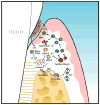Host-response therapeutics for periodontal diseases
- PMID: 18673015
- PMCID: PMC2583215
- DOI: 10.1902/jop.2008.080174
Host-response therapeutics for periodontal diseases
Abstract
Periodontal diseases are initiated by Gram-negative tooth-associated microbial biofilms that elicit a host response, with resultant osseous and soft tissue destruction. In response to endotoxins derived from periodontal pathogens, several osteoclast-related mediators target the destruction of alveolar bone and supporting connective tissues. Major drivers of this aggressive tissue destruction are matrix metalloproteinases (MMPs), cathepsins, and other osteoclast-derived enzymes. This article focuses on the downstream factors of the osteoclast responsible for the degradation of bone and soft tissues around teeth and oral implants. Furthermore, therapeutic approaches that target MMP-2, -8, and -9 inhibition, such as MMP inhibitors, chemically modified tetracyclines, and subantimicrobial formulations of tetracycline analogues, are discussed. The use of rapid, chair-side tests of MMP activity, in particular for MMP-8 and bone collagen fragments, show strong potential as non-invasive measures of tissue health or disease. In addition, studies using other agents for the preservation of bone mass, such as bisphosphonates that inhibit osteoclast recruitment, are highlighted. The application of these bone-preservation strategies to periodontal management and treatment are discussed in the context of high-risk patients susceptible to disease reactivation or disease complications.
Figures





Similar articles
-
Matrix metalloproteinases and their inhibition in periodontal treatment.Curr Opin Periodontol. 1996;3:85-96. Curr Opin Periodontol. 1996. PMID: 8624573 Review.
-
The nonantimicrobial properties of tetracycline for the treatment of periodontal disease.Curr Opin Periodontol. 1994:111-8. Curr Opin Periodontol. 1994. PMID: 8032451 Review.
-
Blocking periodontal disease progression by inhibiting tissue-destructive enzymes: a potential therapeutic role for tetracyclines and their chemically-modified analogs.J Periodontol. 1993 Aug;64(8 Suppl):819-27. doi: 10.1902/jop.1993.64.8s.819. J Periodontol. 1993. PMID: 8410621 Review.
-
Matrix metalloproteinases and periodontal diseases.Oral Dis. 2014 Sep;20(6):538-50. doi: 10.1111/odi.12159. Epub 2013 Jul 15. Oral Dis. 2014. PMID: 23849049 Review.
-
Periodontal Disease as a Risk Factor for Rheumatoid Arthritis: A Systematic Review.JBI Libr Syst Rev. 2012;10(42 Suppl):1-12. doi: 10.11124/jbisrir-2012-288. JBI Libr Syst Rev. 2012. PMID: 27820156
Cited by
-
Host modulation in rheumatoid arthritis patients with TNF blockers significantly decreases biochemical parameters in periodontitis.Inflammation. 2013 Oct;36(5):1171-7. doi: 10.1007/s10753-013-9652-9. Inflammation. 2013. PMID: 23649513
-
Tea polyphenols inhibit the activation of NF-κB and the secretion of cytokines and matrix metalloproteinases by macrophages stimulated with Fusobacterium nucleatum.Sci Rep. 2016 Oct 3;6:34520. doi: 10.1038/srep34520. Sci Rep. 2016. PMID: 27694921 Free PMC article.
-
Synergistic anti-inflammatory activity of the antimicrobial peptides human beta-defensin-3 (hBD-3) and cathelicidin (LL-37) in a three-dimensional co-culture model of gingival epithelial cells and fibroblasts.PLoS One. 2014 Sep 4;9(9):e106766. doi: 10.1371/journal.pone.0106766. eCollection 2014. PLoS One. 2014. PMID: 25187958 Free PMC article.
-
Host modulation therapy: An indispensable part of perioceutics.J Indian Soc Periodontol. 2014 May;18(3):282-8. doi: 10.4103/0972-124X.134559. J Indian Soc Periodontol. 2014. PMID: 25024538 Free PMC article. Review.
-
Cell- and Gene- Based Therapeutics for Periodontal Regeneration.Int J Prev Med. 2015 Nov 4;6:110. doi: 10.4103/2008-7802.169080. eCollection 2015. Int J Prev Med. 2015. PMID: 26682031 Free PMC article. Review.
References
-
- Albandar JM. Periodontal diseases in North America. Periodontol 2000. 2002;29:31–69. - PubMed
-
- Woodward JK, Holen I, Coleman RE, Buttle DJ. The roles of proteolytic enzymes in the development of tumour-induced bone disease in breast and prostate cancer. Bone. 2007;41:912–927. - PubMed
-
- Pussinen PJ, Paju S, Mantyla P, Sorsa T. Serum microbial- and host-derived markers of periodontal diseases: A review. Curr Med Chem. 2007;14:2402–2412. - PubMed
-
- auf dem Keller U, Doucet A, Overall CM. Protease research in the era of systems biology. Biol Chem. 2007;388:1159–1162. - PubMed
Publication types
MeSH terms
Substances
Grants and funding
LinkOut - more resources
Full Text Sources
Other Literature Sources
Miscellaneous

